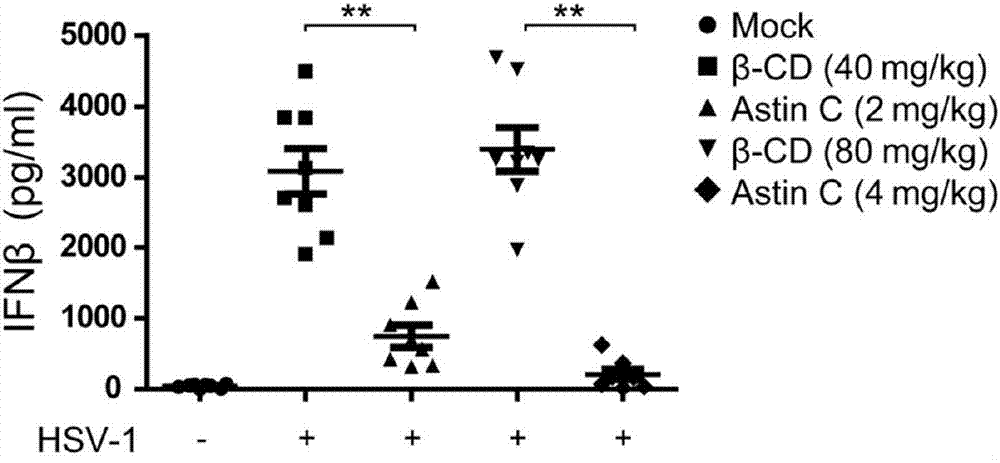Application of Asteraceae cyclopeptides as cGAS-STING (stimulator of interferon genes) signal channel inhibitor
A signaling pathway and compound technology, which is applied in the application of Compositae type cyclic peptides as cGAS-STING signaling pathway inhibitors, and the application field in the preparation of medicines for treating related diseases, can solve the problems of low extraction efficiency, poor repeatability and controllability, The complex process and other problems have achieved the effect of diversifying dosage forms and medication methods and wide clinical application prospects.
- Summary
- Abstract
- Description
- Claims
- Application Information
AI Technical Summary
Problems solved by technology
Method used
Image
Examples
Embodiment 1
[0031] Preparation of Asteraceae type cyclic peptide compounds Astins A-H (1-8) and Astins K-P (9-14): (see the preparation method flow process figure 1 shown)
[0032] Take aster (Aster tataricus L.) dry root and rhizome 10Kg, after drying, pulverizing and soaking in methanol overnight, extract with methanol hot reflux, a total of three extractions, 4 hours for the first time, 4 hours for the second time, 3 hours for the third time hours, the combined extracts were concentrated under reduced pressure to obtain 4.6Kg of methanol extract. The extract was subjected to silica gel column chromatography, eluted with chloroform / methanol (100:0, 9:1, 8:2, 7:3, 1:1, 0:100) gradient elution, and combined with cyclic peptide TLC detection method containing Each fraction of the cyclic peptide was used to obtain the total cyclic peptide part (212.6g); each of the following processes must be combined with the cyclic peptide TLC detection method to guide the separation and purification. T...
Embodiment 2
[0034] The Asteraceae-type cyclic peptide compounds Astins A-H (1-8) and Astins K-P (9-14) prepared in Example 1 were tested in MEF cells for their effects on the expression of genes downstream of the cGAS-STING signaling pathway activated by DNA analogue ISD stimulation. The experimental principles, methods and results are as follows:
[0035] Experimental principle: In the innate immune signal transduction pathway, the cGAS-STING signaling pathway can recognize foreign DNA pathogenic microorganisms that invade the body. Exogenous DNA stimulation can induce the expression of downstream type I interferon genes and interferon-stimulated genes. Therefore, under the stimulation of exogenous DNA (DNA analogue ISD), the activation of the cGAS-STING signaling pathway can be reflected by detecting the expression of the downstream genes IFNβ, IFNα4 and CXCL10, so as to evaluate the effect of the compound on the activation of the cGAS-STING signaling pathway.
[0036] Experimental met...
Embodiment 3
[0040] Example 1 The effect of Astin C (3), a composite cyclic peptide compound prepared in Example 1, on the expression of IFNβ protein in mouse serum induced by HSV-1.
[0041] Experimental principle: The expression of IFNβ protein in the body is a marker event of the innate immune anti-infection response. After the expression of IFNβ, it can activate the interferon receptor (IFNR) signal transduction pathway to induce the expression of cytokines and inflammatory factors such as interferon-stimulated genes, and then By recruiting NK cells or further activating molecular mechanisms such as adaptive immune responses, the invading pathogenic microorganisms are eventually cleared. Therefore, after DNA virus HSV-1 infects mice, the activation of the body's anti-innate anti-infection immune response can be reflected by detecting the expression of IFN-β in the mouse serum, thereby evaluating the effect of the compound on the body's innate anti-infection immune response. influences....
PUM
 Login to View More
Login to View More Abstract
Description
Claims
Application Information
 Login to View More
Login to View More - R&D
- Intellectual Property
- Life Sciences
- Materials
- Tech Scout
- Unparalleled Data Quality
- Higher Quality Content
- 60% Fewer Hallucinations
Browse by: Latest US Patents, China's latest patents, Technical Efficacy Thesaurus, Application Domain, Technology Topic, Popular Technical Reports.
© 2025 PatSnap. All rights reserved.Legal|Privacy policy|Modern Slavery Act Transparency Statement|Sitemap|About US| Contact US: help@patsnap.com



